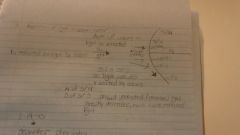![]()
![]()
![]()
Use LEFT and RIGHT arrow keys to navigate between flashcards;
Use UP and DOWN arrow keys to flip the card;
H to show hint;
A reads text to speech;
17 Cards in this Set
- Front
- Back
|
Element |
Variety of atoms |
|
|
Molecule |
2 or more atoms |
|
|
H20 Molecule |
A Dipole Molecule(Molecular magnet) |
|
|
Why do H20 molecules tend to do |
Stick to each other because of hydrogen bonding |
|
|
Hydrogen Bonds |
Give water the quality of strong cohesion Also, creates the property adhesion |
|
|
What physical states can water occur in |
Solid Liquid Gas (0-100c)
|
|
|
Water's heat capacity |
Very High The ability to absorb or release heat energy Heat capacity is measured in Calories |
|
|
Calorie |
The amount of heat needed to raise 1g of pure H20 by 1C |
|
|
Heat |
Energy of moving molecules |
|
|
Tempereature |
Response of a substane to heat energy |
|
|
Sensible heat |
Felt, Measured |
|
|
Latent Heat |
Hidden Heat, that is gained not lost during a change in physical state(SOLID,LIQUID,GAS) |
|
|
Thermal inertia |
Tendency to resist change (water has this) |
|
|
How much ocean water is evaporated annually |
1 Meter |
|
|
How much solar energy is used in evaporation |
1/2 of the solar energy that enter the ocean |
|
|
What are the effects of dissolved salt in water |
Salt, is an antifreeze(lowers the freezing temp) Pure water freezes at 0c Normal seawater @ 1.91c(28.6F)
|
|
|
Refracted light by the ocean |

23.5N 23.5S all light is refractes and abosrbed by oceans |

